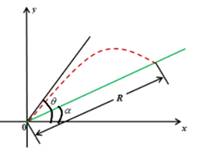
Concept explainers
(a)
To show: The range of the projectile is given by
(a)
Answer to Problem 64RE
Explanation of Solution
Given information:
Parabola is
Calculation:

Consider that
From the figure
Thus,
Next rewrite
From the figure
So,
Hence
(b)
To find: The
(b)
Answer to Problem 64RE
The absolute maximum of
Explanation of Solution
Given information:
The given information is
Parabola
Calculation:
To maximize
Use the identity
The equation
Thus
Therefore, the absolute maximum of
(c)
To find: The range R and angle at which projectile should be fired to maximize R.
(c)
Answer to Problem 64RE
The absolute maximum of
Explanation of Solution
Given information:
The given information is Parabola
Calculation:
Draw a diagram of projectile.

From the figure
Thus,
Next rewrite
From the figure
So,
To maximize, find the derivative of R with respect to
The equation
Thus, the absolute maximum of
Chapter 4 Solutions
Single Variable Calculus: Concepts and Contexts, Enhanced Edition
 Calculus: Early TranscendentalsCalculusISBN:9781285741550Author:James StewartPublisher:Cengage Learning
Calculus: Early TranscendentalsCalculusISBN:9781285741550Author:James StewartPublisher:Cengage Learning Thomas' Calculus (14th Edition)CalculusISBN:9780134438986Author:Joel R. Hass, Christopher E. Heil, Maurice D. WeirPublisher:PEARSON
Thomas' Calculus (14th Edition)CalculusISBN:9780134438986Author:Joel R. Hass, Christopher E. Heil, Maurice D. WeirPublisher:PEARSON Calculus: Early Transcendentals (3rd Edition)CalculusISBN:9780134763644Author:William L. Briggs, Lyle Cochran, Bernard Gillett, Eric SchulzPublisher:PEARSON
Calculus: Early Transcendentals (3rd Edition)CalculusISBN:9780134763644Author:William L. Briggs, Lyle Cochran, Bernard Gillett, Eric SchulzPublisher:PEARSON Calculus: Early TranscendentalsCalculusISBN:9781319050740Author:Jon Rogawski, Colin Adams, Robert FranzosaPublisher:W. H. Freeman
Calculus: Early TranscendentalsCalculusISBN:9781319050740Author:Jon Rogawski, Colin Adams, Robert FranzosaPublisher:W. H. Freeman
 Calculus: Early Transcendental FunctionsCalculusISBN:9781337552516Author:Ron Larson, Bruce H. EdwardsPublisher:Cengage Learning
Calculus: Early Transcendental FunctionsCalculusISBN:9781337552516Author:Ron Larson, Bruce H. EdwardsPublisher:Cengage Learning





